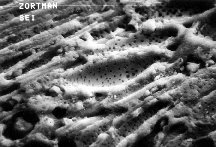Thursday, January 05, 2006
Stretching An Analogy
 This is an electron photomicrograph of the surface of a granule of activated carbon that I took some years ago. Activated carbon is a substance used to purify lots of things. You know the "filtering charcoal" you use in your aquarium -- that is a rather crude version of the same substance.
This is an electron photomicrograph of the surface of a granule of activated carbon that I took some years ago. Activated carbon is a substance used to purify lots of things. You know the "filtering charcoal" you use in your aquarium -- that is a rather crude version of the same substance.See all those little holes? That's why this stuff works. There is an attraction between the surface and the contaminants you wish to remove -- the more hole, the larger the surface, the larger the surface, the more you can purify. The holes, by their size, help create the attractive forces that suck up the contaminants.
Carbon, and other, similar solid materials, zeolytes for example, have drawbacks in application because they are solids --a bunch of engineering stuff that I won't bore you with. "If only you could get those holes into liquid you could solve a lot of those engineering problems." That is the thought behind this headline:
The story is about a group in Northern Ireland at Queen's College that has some grant money to try and get similar effects to activated carbon and related materials in a liquid medium. A fine idea, but it ain't "holes."
As I write, I am resisting the very strong urge to explain this all to you in minute an excruiating technical detail, but you would all tune out. Which is why the particular scientist cited in the story has resorted to this specious and uninformative analog way of describing the research he is undertaking.
My point, in the end, is this. Sometimes when we search for "interesting" ways to communicate science to the masses, we misinform more than we inform. Sometimes, we should just do without the press.





